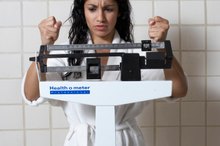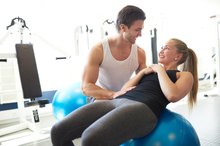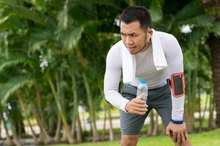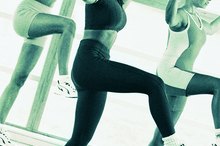What does fact checked mean?
At Healthfully, we strive to deliver objective content that is accurate and up-to-date. Our team periodically reviews articles in order to ensure content quality. The sources cited below consist of evidence from peer-reviewed journals, prominent medical organizations, academic associations, and government data.
- NIH: What Are the Symptoms of a Heart Attack?
- NIH: What Are the Symptoms of a Heart Attack?
- Journal of Clinical Psychiatry: Panic Disorder and Chest Pain: Mechanisms, Morbidity, and Management
- Journal of Clinical Psychiatry: Panic Disorder and Chest Pain: Mechanisms, Morbidity, and Management
The information contained on this site is for informational purposes only, and should not be used as a substitute for the advice of a professional health care provider. Please check with the appropriate physician regarding health questions and concerns. Although we strive to deliver accurate and up-to-date information, no guarantee to that effect is made.
Chest Pains After Bikram Yoga
Bikram yoga -- the original form of "hot yoga" -- is practiced in rooms heated to a tropical 105 degrees Fahrenheit and at least 40 percent humidity 1. This alone is a good reason to make sure you're medically sound before plunging into simulated equatorial torpor. If you experience chest pains after doing Bikram yoga, the good news is that there a number of possible causes that aren't life-threatening 1. If you are having chest pains and are in any risk categories for heart disease (smoking, high blood pressure, overweight) it's important that you tell your doctor about your symptoms.
If you are experiencing serious medical symptoms, seek emergency treatment immediately.
What a Heart Attack Feels Like
Heart attacks cause pain in the chest, and while only your doctor can tell for sure if you’re having a cardiac episode, heart attacks do have their particularities. Most bring pain or discomfort located in the center or left side of the chest. The sensation can feel like squeezing, pressure, fullness or pain – as well as heartburn or indigestion – and it may range in intensity to mild or severe.
The discomfort or pain may last more than several minutes, or it may go away and return. You may also feel pain or discomfort in one or both arms, as well as the back, neck, shoulders, jaw or the stomach above the navel. In some cases, the only symptom may be shortness of breath. Needless to say, if you think you're having a heart attack, get somebody to call 911.
- Heart attacks cause pain in the chest, and while only your doctor can tell for sure if you’re having a cardiac episode, heart attacks do have their particularities.
Avoid Dehydration
Can You Gain Weight By Doing Bikram Yoga?
Learn More
Because of the intense heat and continual movement in Bikram Yoga, it's important to guard against dehydration 1. Chest pains in isolation are usually not a symptom of dehydration, but a racing heart, muscle cramps, dizziness and shortness of breath are -- which in combination could indeed trigger pains in the chest area.
You can lose almost a half gallon of water in a Bikram class, and if you're already a bit dehydrated from previous activity you could run into trouble 1. Many Bikram instructors recommend drinking as much as a gallon of water on days you do Bikram, most of it before and after to avoid nausea and cramping 1.
Muscular Causes of Chest Pain
Muscle spasms in the chest region can also cause chest pain. Bikram, like other forms of yoga, may cause you to strain muscles that have gone unused for too long, or cause twinges in the intercostal chest wall muscles that connect the ribs 1. Chest opening poses, such as Locust, Bow or Fixed Firm in particular, may cause these muscles to spasm.
Another common culprit that can cause severe chest pain and make breathing difficult is the pectoralis minor muscle, the small pec muscle that resides underneath the much larger pectoralis major. Tweak that little fellow and you may find yourself howling like a coyote.
- Muscle spasms in the chest region can also cause chest pain.
- Chest opening poses, such as Locust, Bow or Fixed Firm in particular, may cause these muscles to spasm.
Panic Attack
Stomach Pain & Pilates
Learn More
While romping through 26 asanas in extreme heat and humidity is an invigorating and purifying experience for many, others may find it pushes their hot buttons -- literally and figuratively. Chest pain is a common symptom of panic attacks -- it occurs in up to 70 percent of them -- and panic attacks in turn are an overactive fight or flight response to, among other things, strange and hostile environments. If you find that going to Bikram induces panicky feelings, let alone chest pains, explore other forms of yoga that are practiced with the heat set to much more moderate temperatures 1.
Related Articles
References
- NIH: What Are the Symptoms of a Heart Attack?
- University of Maryland Medical Center: Dehydration
- Journal of Clinical Psychiatry: Panic Disorder and Chest Pain: Mechanisms, Morbidity, and Management
- Chan J, Natekar A, Koren G. Hot yoga and pregnancy: fitness and hyperthermia. Can Fam Physician. 2014;60(1):41–42.
- Hewett ZL, Cheema BS, Pumpa KL, Smith CA. The Effects of Bikram Yoga on Health: Critical Review and Clinical Trial Recommendations. Evid Based Complement Alternat Med. 2015;2015:428427. doi:10.1155/2015/428427
- Sears ME, Kerr KJ, Bray RI. Arsenic, cadmium, lead, and mercury in sweat: a systematic review. J Environ Public Health. 2012;2012:184745. doi:10.1155/2012/184745
Writer Bio
Martin Booe is a health, fitness and wellness writer who lives in Los Angeles. He is currently collaborating on a book about digital addiction to be published in the UK this December.









